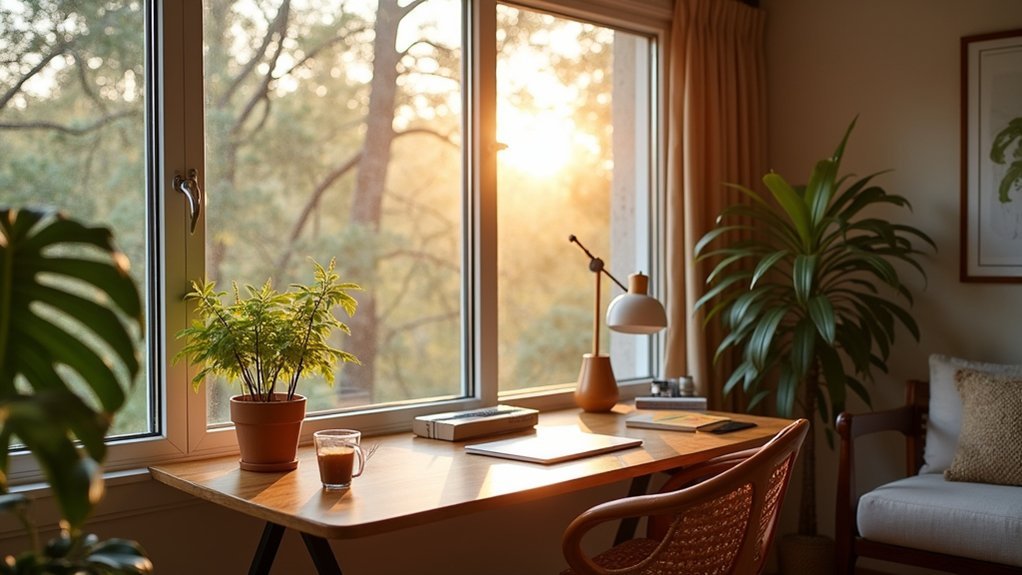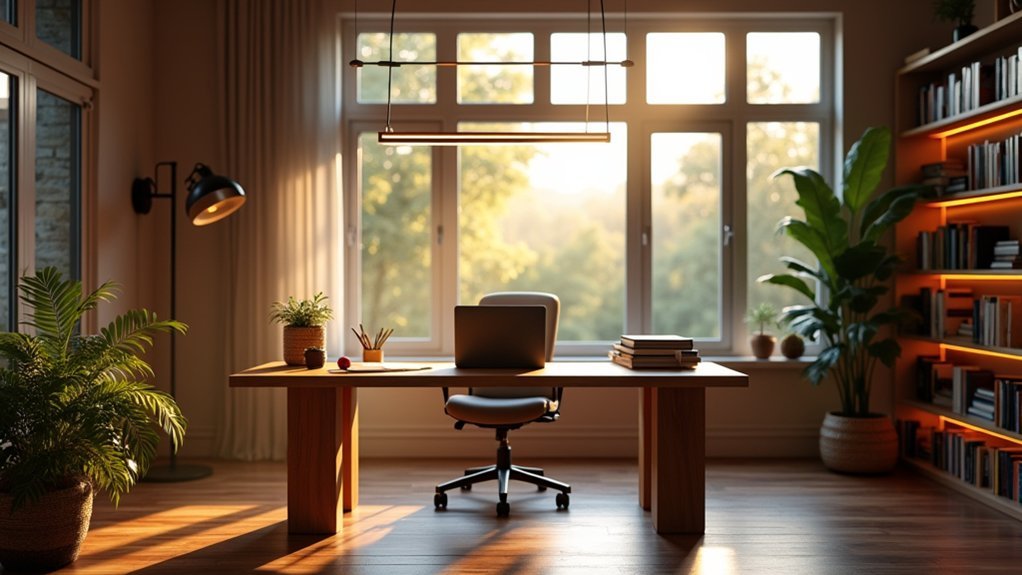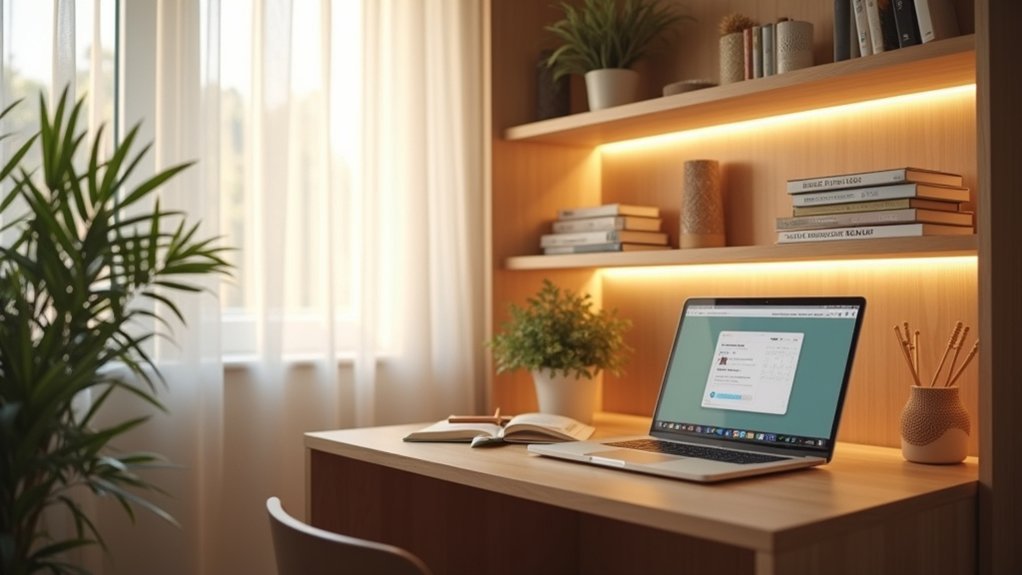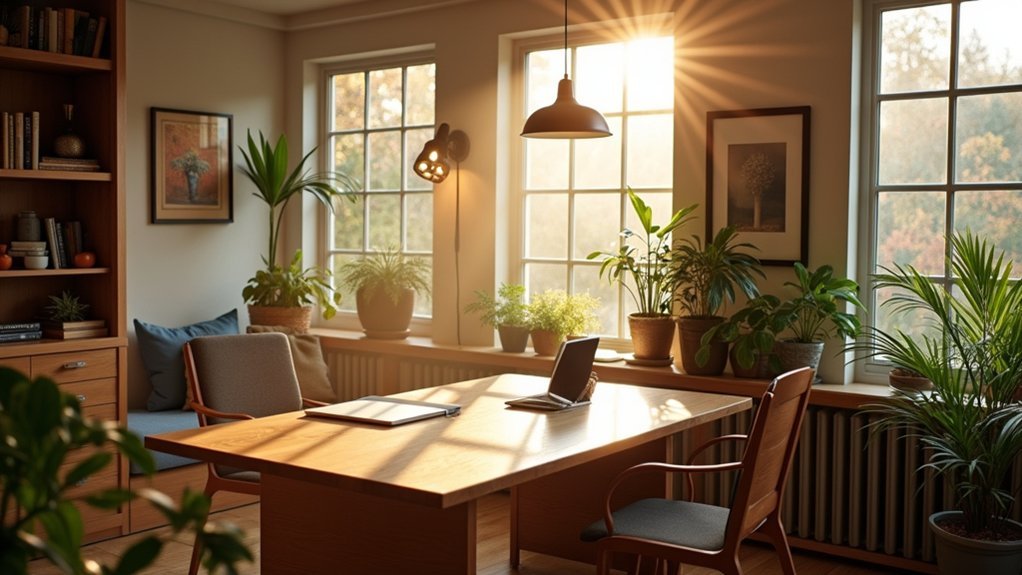Illuminate your home office intelligently by positioning windows strategically, installing adjustable desk lamps, creating multi-layer lighting systems, and controlling color temperature for productivity. Automate your lighting schedule, implement voice-controlled solutions, choose energy-efficient LEDs, establish distinct lighting zones, and integrate light sensors for adaptive brightness. Don’t forget to eliminate glare with proper light positioning and diffused options. These smart lighting strategies will transform your workspace into a productivity powerhouse.
Strategic Window Placement for Optimal Daylight Harvesting

When designing a home office, strategic window placement can transform your workspace by maximizing natural light while minimizing potential drawbacks.
Consider orientation carefully: north-facing windows provide consistent, glare-free light, while east-facing ones deliver energizing morning sunlight that boosts alertness. Position windows at 30-40% window-to-wall ratio for ideal balance between daylight and energy efficiency.
For uniform illumination, choose horizontal windows placed higher on walls. This configuration reduces glare and increases usable wall space while improving daylight distribution. Square windows positioned centrally minimize excessive sunlight exposure.
Remember that proper window placement isn’t just about aesthetics—it directly impacts your health and productivity. Workers with window access sleep better and experience greater well-being. Implementing effective daylight harvesting techniques can significantly reduce your lighting costs and overall energy consumption, particularly important in urban home offices.
Use daylight analysis tools to optimize placement for your specific space and climate.
The Perfect Task Light: Features to Look for in Desk Lamps
After optimizing your window placement, complementary task lighting becomes the next key element in creating an effective home office environment. Your desk lamp should combine functionality with design while addressing your specific needs. For optimal visibility and reduced eye strain, position your lamp 15 to 30 inches above your desk surface.
| Feature | Benefit |
|---|---|
| Adjustability | Customizes light direction to reduce shadows |
| LED Technology | Provides energy efficiency with minimal heat |
| Anti-Flicker | Prevents eye strain during extended work |
| USB Ports | Offers convenient device charging |
| Ergonomic Design | Enhances comfort during long work sessions |
Consider your specific requirements when selecting a lamp. If you’re working in tight quarters, a clip-on or foldable design saves valuable space. For reducing eye fatigue, look for lamps with dimming capabilities and warm tone settings. Budget-conscious shoppers might appreciate the IKEA FORSÅ, while those seeking premium features should explore the BenQ e-Reading LED.
Creating a Multi-Layer Lighting System for Versatile Workspaces

Beyond a single desk lamp, truly effective home office lighting requires a strategic multi-layer approach. Combine ambient lighting for general illumination, task lighting for focused work, and accent lighting to highlight design elements.
Start by evaluating your workspace zones to determine appropriate lighting needs. Install ceiling fixtures or recessed lights for ambient coverage, then add adjustable desk lamps positioned to minimize shadows and glare. Consider selecting LED lighting with color temperatures between 4000K-5000K for optimal focus during work hours.
A thoughtful lighting plan begins with workspace analysis, combining overhead solutions for general coverage with strategic task lighting to eliminate workspace shadows.
Wall-mounted or floor lamps can provide additional layers while saving desk space. Incorporate dimmers to control intensity based on your activities throughout the day.
This multi-layered strategy enhances productivity, reduces eye strain, and allows you to selectively use only the lighting you need—saving energy while creating an inviting atmosphere for both independent work and virtual meetings.
Smart Color Temperature Control for Enhanced Productivity
You’ll boost your workday effectiveness by programming smart lights to follow your body’s natural rhythms, shifting from energizing cool tones in the morning to warmer hues as evening approaches.
Create designated focus zones in your home office where you can adjust color temperature based on the task at hand—cooler settings for detailed work and warmer ones for creative thinking.
These customizable lighting environments let you quickly switch between different work modes without disrupting your concentration or comfort. Selecting the optimal 4000K color temperature provides a neutral tone that prevents eye strain during extended work sessions while maintaining a professional atmosphere.
Circadian-Aligned Lighting Schedules
When it comes to optimizing your home office, the science of circadian-aligned lighting offers a powerful productivity boost that’s often overlooked. By mimicking natural sunlight patterns, you’ll enhance your mental function and memory recall throughout the workday.
Implement automated lighting that shifts from cool, blue-rich light in the morning to stimulate alertness, to warmer amber hues in the evening to promote relaxation. These gradual changes support your body’s natural biological clock without requiring manual adjustments. Studies show that indoor work environments often lack sufficient natural light, making intentional lighting design crucial for home offices.
For maximum effectiveness, personalize your lighting schedule to match your individual circadian rhythm. Maximize exposure to bright, full-spectrum light during your peak productivity hours, while dimming intensity during low-impact periods to conserve energy without sacrificing performance.
Adaptable Focus Zones
Creating adaptable focus zones takes your home office lighting to the next level by incorporating smart color temperature control. Set up distinct areas with tunable LED fixtures that adjust between 3500K-5500K based on your activities. Customizing your lighting scenes based on specific tasks enhances overall task engagement and fosters a more efficient workspace.
| Activity | Ideal Temperature | Benefits |
|---|---|---|
| Regular office tasks | 4000K-4500K | Balanced lighting, reduced eye strain |
| Intense focus work | 5000K-5500K | Enhanced alertness and concentration |
| Creative brainstorming | ~3500K | Promotes relaxation and creativity |
| Reading documents | 4000K-4500K | Visual clarity without harshness |
| Shift periods | 3500K-4000K | Signals task shifts, eases shifts |
Program your lighting system to automatically adjust throughout the day or control it via voice commands and apps. Incorporate motion sensors to activate specific lighting scenes as you move between zones, minimizing disruptions and maximizing productivity without manual adjustments.
Automating Your Lighting Schedule to Support Work-Life Balance

While the boundaries between professional and personal time often blur in home offices, automating your lighting schedule can create an essential distinction between work hours and downtime.
Set up timer-based lighting using smart switches that automatically adjust throughout your day, signaling changes between work modes.
Create customized scenes with systems like Lutron or Control4 that dim lights gradually as your workday ends. You’ll benefit from voice-controlled scheduling through Google Home or Alexa integration, allowing hands-free adjustments when needed. You can also utilize motion sensors that automatically activate lights when you enter your workspace in the morning.
Many systems also monitor energy usage, helping you optimize consumption.
For maximum effectiveness, implement automation scenarios where lights shift to warmer tones after work hours.
Color-tuning features can simulate natural daylight during productive periods and softer ambiance during personal time, reinforcing healthy work-life boundaries.
Glare Elimination Techniques for Screen-Based Work
For professionals spending hours in front of screens, eliminating glare becomes essential to prevent eye strain and maintain productivity.
Position light sources to the side of your workspace rather than directly overhead or in front of your monitor. This simple adjustment markedly reduces reflections on your screen.
Incorporate diffused lighting options like frosted pendant lights or LED panels with diffusers to create even illumination without harsh contrasts. Utilizing smart lighting systems can automatically adjust brightness based on changing conditions throughout your workday.
Task lighting with adjustable desk lamps gives you personalized control while minimizing reliance on glaring overhead fixtures.
Consider indirect lighting solutions such as uplighting or wall-mounted fixtures that bounce light off ceilings and walls.
These create a softer, more comfortable visual environment.
If you wear glasses, opt for anti-reflective lenses and use blinds to control natural light throughout the day.
Voice-Controlled Lighting Solutions for Hands-Free Adjustment
You can enhance your home office experience by connecting smart lighting with voice assistants like Alexa, Google Assistant, or Siri for hands-free control throughout your workday.
With simple verbal commands, you’ll create custom lighting scenes for focused work, video calls, or relaxed reading without interrupting your workflow.
Voice-controlled lighting particularly benefits those with mobility limitations, allowing everyone to maintain ideal illumination without the need to reach for switches. Many smart lighting options allow you to establish automated scheduling features that can improve your productivity by adjusting brightness and color temperature throughout different times of your workday.
Smart Assistants Integration Options
When setting up voice-controlled lighting in your home office, integrating smart assistants creates a seamless hands-free experience that enhances both productivity and comfort.
Both Google Assistant and Amazon Alexa offer robust compatibility with popular smart lighting systems like Philips Hue, Lutron Caseta, and Cync Smart Bulbs.
For successful integration, you’ll need to:
- Register your devices in their dedicated apps first, then connect them to your preferred voice assistant.
- Consider hub requirements – some systems like Philips Hue need a hub while Cync bulbs can connect directly to assistants.
- Verify compatibility between your chosen lighting products and voice assistant to guarantee all features work properly.
This setup particularly benefits those with mobility challenges while offering everyone the convenience of adjusting lighting without interrupting workflow. You can use simple voice commands like “set lights to 25%” to instantly change your office illumination without leaving your desk.
Lighting Scenes Verbal Commands
Voice-controlled lighting scenes transform your home office experience by enabling sophisticated light management through simple verbal instructions.
Create scenes with descriptive names like “Focus Mode” or “Video Call” through your smart lighting app to guarantee reliable voice recognition.
Use basic commands such as “turn on,” “dim lights to 50%,” or activate complete environments by saying “set office to Reading Mode.”
For maximum efficiency, group lights logically and keep naming conventions consistent across your system.
You’ll enjoy hands-free adjustment during intensive work sessions, eliminating disruptions while switching between brightness levels appropriate for different tasks.
Consider using Smart Home Groups feature to organize devices by location for more intuitive control when managing multiple lights in your office space.
Test commands in your typical working environment to guarantee reliability, and leverage percentage-based dimming for precise control.
Regular software updates will continually improve recognition accuracy and expand voice command capabilities.
Accessibility Benefits Overview
Transforming the home office experience for everyone, accessibility stands at the forefront of voice-controlled lighting benefits.
You’ll gain independence through hands-free operation, eliminating the need to interrupt your workflow to adjust lighting conditions. Voice commands provide consistent control regardless of your physical abilities or location within your workspace. The integration of advanced Natural Language Processing capabilities is making these systems increasingly intuitive and responsive to varied voice patterns and commands.
- Enhanced independence – If you have mobility challenges, voice commands allow light adjustments without physical strain, promoting self-sufficiency in your home office environment.
- Seamless multitasking – Control lights while your hands remain occupied with important tasks, boosting your productivity.
- Universal design – Enjoy standardized lighting control that works for everyone, with support for multiple languages and personalized command options.
Energy-Efficient Lighting Choices That Reduce Your Carbon Footprint
As you set up your home office, choosing the right lighting doesn’t just affect your productivity—it greatly impacts your environmental footprint.
LED lights use up to 80% less energy than traditional bulbs while lasting much longer and containing no toxic substances like mercury.
You’ll benefit financially too. Despite higher upfront costs, LEDs reduce utility bills and replacement frequency, offering considerable long-term savings.
Consider layering your lighting with task-specific fixtures to minimize unnecessary energy use, and position your desk near windows to maximize natural light. Proper lighting placement eliminates shadows and reduces the need for additional energy-consuming fixtures.
For additional efficiency, install motion sensors or smart controls that automatically adjust brightness or turn off lights when you’re away.
Look for ENERGY STAR certification when purchasing fixtures to guarantee you’re getting truly efficient options that minimize greenhouse gas emissions.
Lighting Zones: Customizing Illumination for Different Office Activities
You’ll achieve maximum productivity by creating specific lighting zones for different home office activities.
Set up task lighting where you need focused illumination for computer work or reading, while using ambient lighting for video calls and creative sessions.
Control the brightness in each zone with dimmers or adjustable fixtures to match your energy levels and the visual demands of each activity throughout your workday. Consider incorporating programmable LED bulbs that allow you to customize color temperatures to suit different tasks and times of day.
Task-Specific Light Layout
When designing your home office lighting, strategically dividing your workspace into distinct zones will dramatically improve both comfort and productivity.
Position task lights at a 45-degree angle from your workspace to minimize screen glare and prevent shadows when writing or reading. For computer work, cooler light (4000K-5000K) enhances concentration, while creative areas benefit from warmer tones (2700K-3000K). Creating spaces that feel alive requires multiple light sources to add depth and dimension to your workspace.
- Desk Area – Install adjustable desk lamps with flexible arms that can direct light precisely where needed, especially for detailed paperwork or drawing tasks.
- Computer Zone – Use under-shelf lighting to reduce eye strain while keeping direct light off your screen.
- Meeting Space – Combine ceiling fixtures with supplemental task lighting that can be adjusted for video calls or in-person discussions.
Activity-Based Brightness Control
Creating distinct lighting zones within your home office allows you to tailor illumination levels precisely to each activity you perform throughout the day. By dividing your space into functional areas—desktop, reading corner, or video conference spot—you’ll experience enhanced visual comfort and reduced eye strain.
Implement this system using occupancy sensors that automatically adjust lighting when you enter different zones. Integrate daylight sensors to balance artificial light with natural illumination, conserving energy while maintaining ideal brightness. Lutron’s Diva Smart Dimmer provides exceptional ELV+ lighting control that’s perfect for creating these customized environments.
Wireless controls make retrofitting easy without extensive rewiring. You’ll benefit from improved productivity as each task gets appropriate lighting, plus lower electricity bills as unused zones dim automatically.
Consider voice or app controls for seamless shifts between activities, or explore AI-driven solutions that learn your preferences and adjust lighting dynamically.
Integrating Light Sensors for Adaptive Brightness Throughout the Day
As natural light fluctuates throughout the day, integrating light sensors into your home office setup can transform how you experience workplace illumination.
These intelligent devices continuously monitor ambient brightness levels, automatically adjusting your artificial lighting to maintain ideal visibility without manual intervention. Light sensors detect visible light levels and measure illuminance in lux for accurate brightness assessment in your workspace.
- Strategic placement matters – Position sensors near windows to capture daylight variations accurately, or combine with motion detection to prevent lighting empty rooms.
- Choose the right sensor type – Lux sensors directly measure light intensity, while PIR sensors incorporate occupancy detection for enhanced energy savings.
- Calibrate for your space – Consider your room size, window exposure, and lamp types during setup to prevent lighting from toggling unnecessarily.
You’ll enjoy improved visual comfort, reduced energy consumption, and consistent light levels that support productivity throughout changing daylight conditions.
Frequently Asked Questions
How Does Lighting Affect Video Call Appearance?
Poor lighting causes pixelation and unflattering shadows on your face. You’ll look better with soft, diffused light at eye level, avoiding harsh overhead lighting that accentuates imperfections and creates unnatural skin tones.
Can Certain Lighting Reduce Headaches and Eye Fatigue?
Yes, certain lighting can reduce headaches and eye fatigue. You’ll benefit from high-frequency fluorescent lights with minimal flicker, natural daylight, and controlled brightness. Avoid harsh contrasts and consider specialized glasses for light sensitivity.
What Lighting Solutions Work Best for Small or Windowless Offices?
You’ll want layered LED lighting with daylight simulators, wall-mounted mirrors, and full-spectrum bulbs. Combine overhead diffused fixtures with adjustable task lights and add vertical light panels to create depth in your windowless space.
How Should Lighting Be Adapted for Left-Handed People?
Position your light source on the right side to minimize shadows when you’re writing. Use adjustable desk lamps opposite your dominant hand and aim for natural white light (4000K-5000K) to reduce eye strain.
Do Plants Affect Lighting Distribution in Home Offices?
Yes, your plants affect light distribution by absorbing and diffusing light. They can block 10-40% of light behind them, soften shadows, and reduce glare. Position them beside your desk rather than between you and light sources.
In Summary
You’re now equipped to transform your home office with intelligent lighting that enhances productivity and wellbeing. By combining natural light, task-specific illumination, and smart technology, you’ll create a workspace that adapts to your needs throughout the day. Remember, proper lighting isn’t just about seeing clearly—it’s about supporting your energy levels, mood, and focus. Implement these strategies and you’ll notice the difference immediately.





Leave a Reply